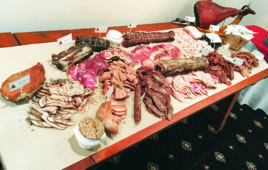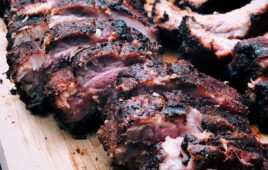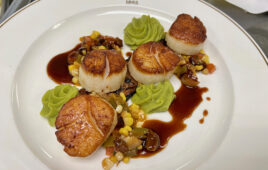
lobster thermidor by Olivier Burgos, CEC, Executive Chef, Royal Oaks Country Club
Menu development is a complicated process, but it’s a skill club chefs must hone to compete with area restaurants and cement themselves as a true dining destination for their members.
For Olivier Burgos, CEC, Executive Chef of Houston’s Royal Oaks Country Club, inspiration for seasonal menus and monthly specials come from all over the world.

Olivier Burgos, CEC, Executive Chef, Royal Oaks Country Club
“A lot of my inspiration comes from my travels,” says Burgos. “When I travel, I travel to discover what the locals eat. I take notes and take pictures; I try every food I can. I always come back with ideas and try to reproduce or adapt the food for the members.”
Burgos, a French native, worked in numerous Michelin-starred restaurants in Paris but spent most of his career abroad. He traveled throughout Asia, working as a cook in Singapore, Malaysia and Indonesia to learn more about the cuisine. And he spent the better part of two decades in Australia, where he opened and sold an award-winning restaurant.
“That’s what I’ve been doing in my life: going to different countries and staying there a year or two, sometimes longer, and learning,” he says.
In 2017, he accepted a position as Head of Culinary Arts at Houston’s Culinary Institute Lenôtre, the only culinary Institute in the U.S. run by French natives. In 2021, he became Executive Chef of Royal Oaks, which boasts a relatively young and diverse membership, representing many different cultures and countries.
A la carte menus change every three months, plus daily and weekly specials and new items, focusing on scratch-made, seasonality and high-quality produce purveyors.
“My young members don’t want [traditional] club food,” says Burgos. “They want the club to be a restaurant destination, somewhere they can bring their guests.”
Each month, Burgos plans a buffet with a different cuisine: most recently, Middle Eastern and Italian. Up next is Greek and then Spanish, with Nigerian on the horizon. Burgos hosts a monthly chef’s table experience for 12 with a surprise menu and other themed dinners, which feature eight sources surrounding a local ingredient. In May, it’s a local Wagyu beef producer.
“I want to emphasize producers,” Burgos says. “The food tastes good because we get the best producers around. They support us, and we support them. They’re quality products, so their name will be on the menu.”

Dale Sampson, CEC, Executive Chef, Fairlawn Country Club
A La Carte Creations
Like Burgos, Executive Chef Dale Sampson, CEC, starts with what’s in-season when planning menus at Fairlawn Country Club (Akron, Ohio), prioritizing fresh, local and responsibly sourced ingredients.
“We have a pretty aggressive a la carte system,” Sampson notes. “We have two new menus daily and one stationary menu, [updated] each season.”
Sampson plans each menu with two sous chefs and the club’s banquet chef, drawing inspiration from “everywhere”—local chefs, magazines, books, TV, TikTok.
“Between the four of us, we have a good dialogue, and we usually come up with some great ideas,” he says. “It’s cool to be somewhere where I can have an idea at 11 p.m. and throw it on the menu the next day, and it sells.”
Sampson says the younger members, in particular, are “always willing to try new things, from different peppers to new plating techniques.”
“Our spring menu has quite a bit of Asian influence,” he adds. Features included tempura surimi, with Alaskan pollock, nori, calrose rice, avocado and Mae Ploy aioli; and Asian-inspired diver scallops with ginger sauce, carrot, asparagus, zucchini and sesame.
“Thursdays are ‘Traditional Favorite Day,’” says Sampson, “where we make items for some of the older, more traditional members—anything with piccata goes over really well.”

Daniel Fish, Executive Chef, Bear Creek Golf Club
When Daniel Fish started as Executive Chef of Bear Creek Golf Club in Murrieta, Calif., five years ago, the culinary program was “kind of old-school,” he says. Since then, he’s brought in local suppliers, fresh, high-quality produce, new flavors, and sauces.
Now, Bear Creek’s members have more than warmed to his “low and slow” house-smoked barbecue and wood-fired pizzas, a feature the club added in 2022. Pizzas are fired on Fridays, with specials that always sell well. Recent examples include a carnitas pizza and a white pizza with a parmesan-garlic sauce, mozzarella, tomato and artichoke.
He and his team are brainstorming new uses for the ovens, with plans to start ”roasting bigger pieces of meats, like prime rib, some steaks,” Fish says. “We’ll also start doing our own breads and bagels.”
At Bear Creek, a la carte menus are updated seasonally, sometimes more often, plus regular events like monthly wine dinners and weekly themed menus like Taco Tuesdays. Fish starts with what’s in season, then he researches recipes and trends, looking to sites like Instagram and Pinterest and his “hundreds of cookbooks.” He reaches for Richard Blais’ books and The Flavor Bible most often.
He also leans on his experience running a catering company and several gastropubs and food trucks, crafting “menus and dishes that had complex flavors but were simple to make,” Fish says. “It helped me create items that I know can be done with a sense of urgency.”
Leading an operation means creating menus with all factors front of mind. Ease of execution is paramount.
“Every chef dreams of writing a menu and doing whatever they want,” says Burgos.
When menu-planning at Royal Oaks, he starts with an idea, then works with his sous chef to test and fine-tune, running through every variable: How long will it take to plate? What does it cost? Is it possible with the culinary team available?
“First, the food has to be good,” says Burgos. “But second, it has to be feasible.”













